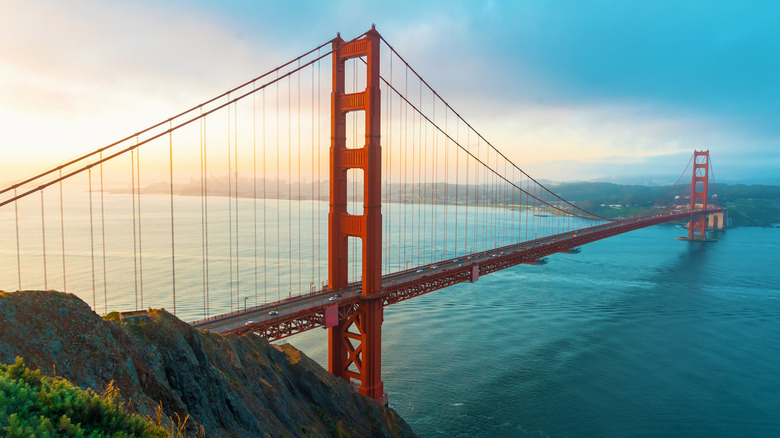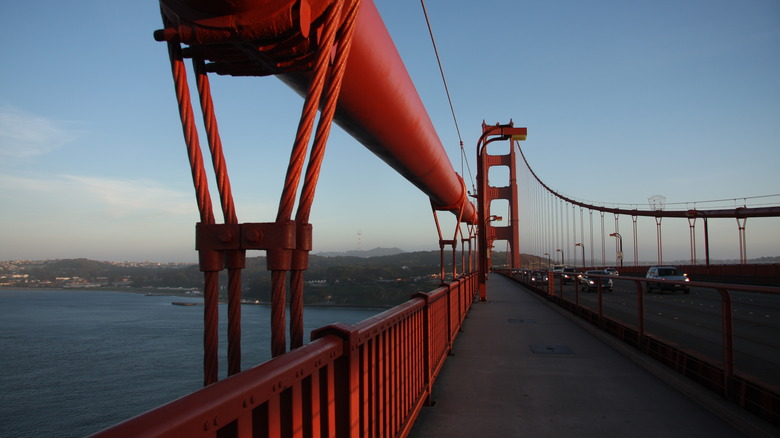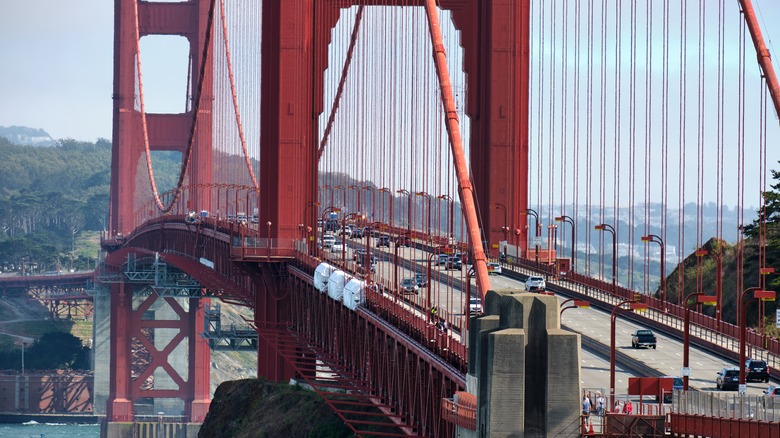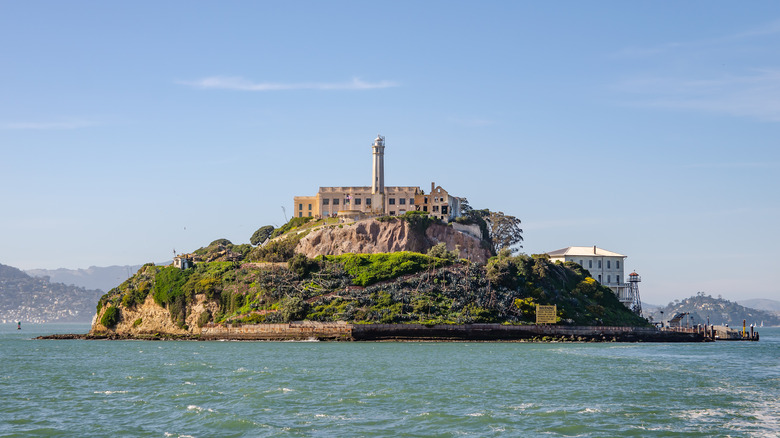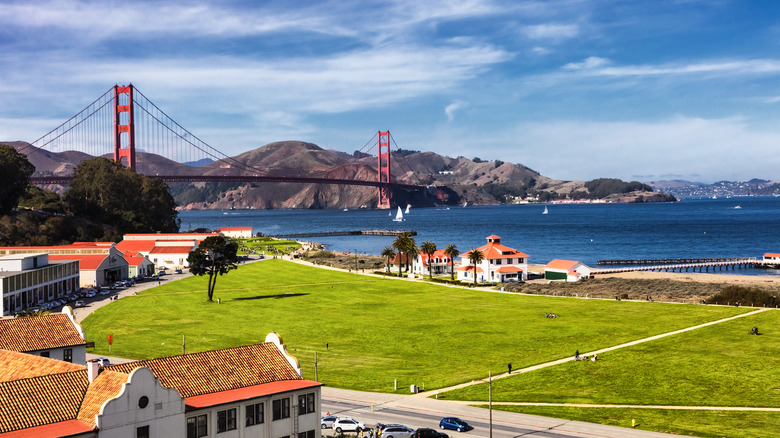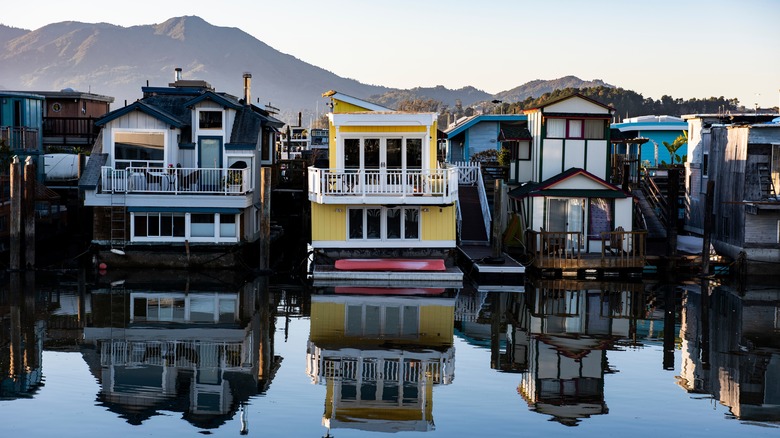First-Timers' Guide To Walking The Golden Gate Bridge
Can you fall in love with a bridge? Ask the 10 million people who visit San Francisco's magnificent Golden Gate Bridge every year. The 1.7-mile-long bridge is an iconic structure that spans the strait of the Golden Gate and links the city of San Francisco with Marin County to the north. Painted in International Orange, the bridge's 746-foot towers soar toward the sky, and its elegant art-deco architecture is admired worldwide.
When it was built in the 1930s, the bridge was quite the feat of engineering. In fact, one of the most spectacular things about the Golden Gate Bridge was that it opened ahead of schedule and under budget in 1937. And, when it opened, it was both the longest and the tallest suspension bridge in the world and remained so for many years.
To this day, the Golden Gate Bridge is one of San Francisco's biggest tourist attractions. You can catch a glimpse of the bridge from many of the city's other attractions, including Alcatraz Island, Fisherman's Wharf, and the upmarket neighborhood of Nob Hill.
Walking across the Golden Gate Bridge
First of all, yes, you can absolutely walk across the Golden Gate Bridge. In fact, it was opened to pedestrians before it was opened to vehicular traffic (only one day before, but it was a real party). You can also cycle across if that takes your fancy. As we said, the bridge is 1.7 miles long; it will take most people 45–60 minutes to walk across it, including several stops to admire the scenery. There is a slight incline as you walk toward the middle of the bridge, but the walk shouldn't be challenging for most people. There are public restrooms at both ends of the bridge, but none on the bridge itself.
You're definitely going to want to check the weather before you embark on your walk across the bridge. Mornings are often foggy, meaning the picturesque views can be obscured. And, though the fog often lifts by the afternoon, this time of day can be very windy year-round. Finally, you can expect some rain in winter and spring. Don't be put off! There's no bad weather, just the wrong clothes, so as long as it's safe to cross the bridge, layer up, bring along a waterproof jacket and a warm hat, and enjoy the fresh air. September and October often have better weather than July and August (and it's cheaper to visit outside of the summer months).
How to get there and when to go
This should be obvious, but we're going to say it anyway: You can't drive onto the Golden Gate Bridge, merrily pull over somewhere in the middle, and go for a leisurely stroll. If you're driving to the bridge, you need to park your vehicle before you get on. There are visitor parking lots on the southeast side (San Francisco) and the northeast side (Marin County) near the base of the bridge. At the southeast side, you can park for a maximum of three hours for $5 per hour. Parking is free on the northeast side, and you can park for a maximum of four hours.
However, we absolutely do not recommend driving to the bridge if you're planning to walk across. There are high levels of vehicular break-ins, with property theft common. Take a ride-share or arrive by public transport instead. The official Golden Gate Bridge site has recommendations for taking public transit.
The bridge is open for pedestrians from 5 a.m. to 6:30 p.m. from November to March and closes at 8:00 p.m. the rest of the year. Walkers must use the east sidewalk. A note about the crowds: The hike across the bridge can become more of a shuffle at peak times. Try to visit on a weekday or between 3:30 p.m. and 6:30 p.m., when the east sidewalk is closed to cyclists. Oh, and it's free to walk across the bridge!
What you can see from the bridge
Now for the exciting part! You're on the bridge; what can you see? If you're starting from the San Francisco end, look down to see the Civil War-era Fort Point National Historic Site from above as you begin your walk. Looking further off toward the east, you should be able to see Crissy Field and the magnificent Palace of Fine Arts. As you come to the Marin County side of the bridge, you'll be able to look down on Fort Baker and up to Battery Spencer, which sits on the Marin Headlands.
The star of the show though is the whole panorama. From the bridge, you'll have spectacular views across downtown San Francisco, Alcatraz Island, and over the bay, which only get better as you walk further toward Marin County. On top of that, you'll have views of Angel Island — San Francisco Bay's largest natural island — which can only be reached by boat and is a wonderful day trip from the city. Looking towards Marin County, you can see the Marin Headlands rearing up, creating a stunning backdrop for your walk. Bring binoculars to enjoy the views even more.
Routes across the Golden Gate Bridge
Sure, there's only one route across the bridge itself, but which end should you start from, and where should you begin or end your walk? First, you don't have to walk both ways across the bridge as there are plenty of public transit options to get you back and forth. Most people start from the Welcome Center on the San Francisco side, where you can learn about the history of the bridge and get an insight into what a feat of engineering it truly was. From there, you can simply walk across the bridge to Vista Point in Marin County and take the bus back.
For a glorious run-up to the bridge, start at the east end of Crissy Field and walk along the level pathways, with the bridge — as well as Alcatraz Island and the sweeping bay — in your line of sight. Alternatively, you can walk the stunningly scenic California Coastal Trail from Baker Beach to the Golden Gate Bridge. And, of course, you can start from Marin County if you want to take the bus across and then walk back with a view of San Francisco's skyline.
Finally, if you'd like to really learn more about the construction of the bridge and its history, you can take a free walking tour with San Francisco City Guides on Thursdays and Sundays.
What to do around the bridge
There are so many things to see and do around the bridge that you could easily turn it and its surroundings into a full day out. On the San Francisco side, you can take a tour of Fort Point and go for a walk around the Palace of Fine Arts. There are also, of course, all of the attractions of San Francisco on offer nearby. For a completely different perspective of the bridge, consider taking a boat tour that will take you underneath the huge structure.
On the Marin County side, there's plenty to keep you entertained too. There are lots of viewpoints, including the Golden Gate Observation Deck and right up on the top of Hawk Hill. If you feel like walking a bit further, head on to charming Sausalito — the total distance including the bridge crossing from the city will be around 4 to 4.5 miles. In Sausalito, there are tons of art galleries and boutiques to explore and some fabulous restaurants to fuel up after your hike. If you've made it to Sausalito, we highly recommend taking a ferry back to San Francisco if it's convenient.
